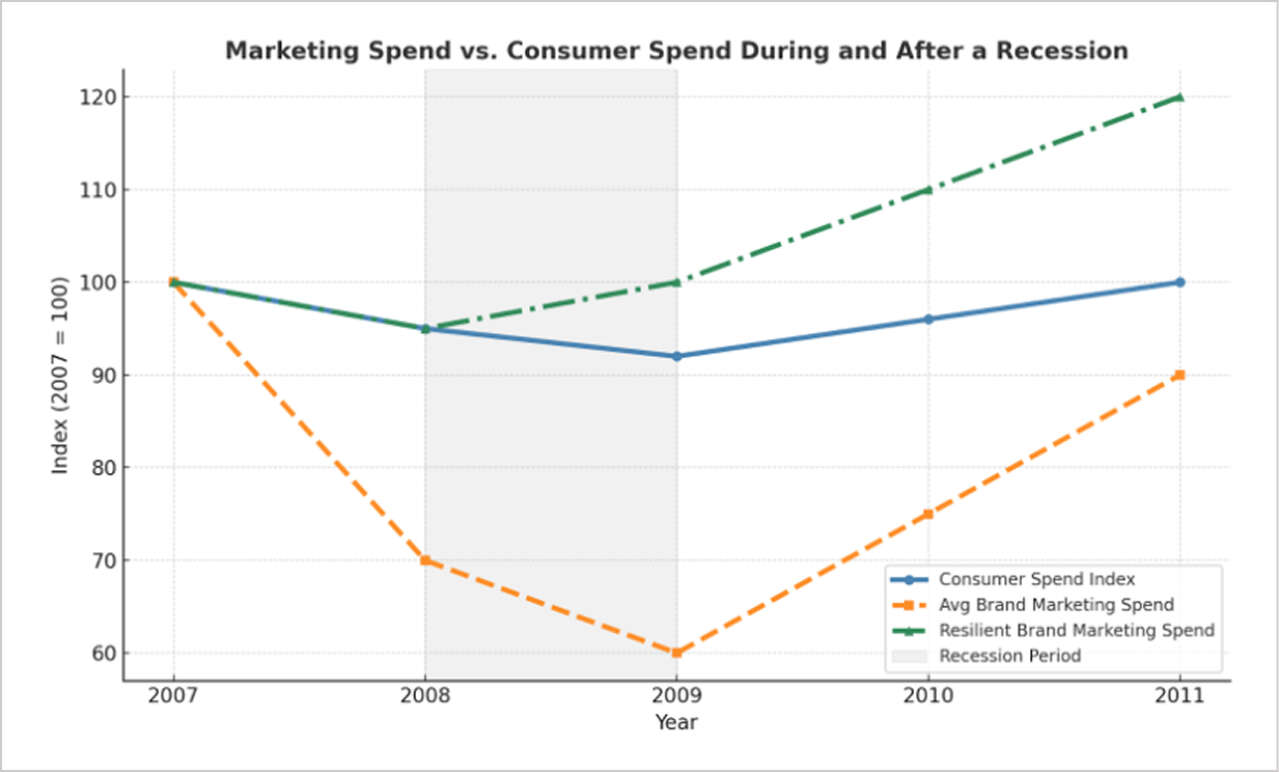
How Brands Can Embrace Uncertainty, Create Opportunity in an Economic Downturn
Is America heading for a recession? The answer depends on who you ask, but for us, the answer leans quite heavily toward a “yes.” Why? Because if every chief marketing officer put together a top-five list of concerns, “recession” would be on many of those lists right now.
For many of our clients, tariffs and trade wars loom large. If their product inventory and sales margins aren’t directly impacted by rising import taxes, they’re anticipating the effects of consumer uncertainties and recession-like buying behaviors. If you pan out beyond what we’ve observed in our day-to-day interactions with clients and their company’s targeted consumers, general polling substantiates where the minds of many can be found: Four in 10 Americans say the U.S. is in a recession, according to the latest Economist/YouGov Poll.
And that ratio is enough to influence consumer trends in unwanted ways.
“I’ve been through two recessions here at Lewis and, now, possibly a third,” said Jennifer Carter, vice president of channel engagement. Carter, a comparatively young ad executive to have experienced three notable economic declines, weathered the housing market crash and subsequent Great Recession in 2008, the U.S. economy’s response to a global pandemic in 2020 and, finally, tariffs and trade wars in 2025.
Yet, as history affirms, three recessions in 17 years is actually right on time. In the era of modern capitalism, or roughly since World War II, significant declines in economic activity tend to occur every five to seven years. So for any company facing a market downturn, the cliche rings true: It’s not a matter of if, but when.
“With each of these experiences, you’re problem-solving around less-than-ideal economic trends, but you begin to recognize consistencies within the chaos,” said Carter.
She said the conversations and problems are varied, and each represents situations unique to specific market downturns and industries. But what Carter and her colleagues have observed over and over again is how often there are common through lines across every industry and every economic downturn.
“It becomes easier to anticipate the resulting problems of an economic downturn and quickly identify where the opportunities are going to be,” she said.
And there will be opportunities. If we accept the inevitability of the economy’s boom and bust cycles, we can also be galvanized by its promises:
Each phase of any cycle is not infinite.
Cyclical behavior assures that what swings downward will soon swing upward again.
Economic valleys really do signal opportunity in ways that have been proven in both distant and recent history.
Anticipation and Healthy Partnership Are Gateways to Opportunity in a Downturn
True partnership between agency and client becomes paramount in any downturn. Without the residual upside of seamless collaboration, it’s more difficult to anticipate what’s to come and have the conviction to prepare for what’s not yet present.
“The 2020 recession wasn’t just a hardship to overcome — it was an opportunity for prepared partners,” said Jennifer Dira, vice president of account services at Lewis. Dira experienced firsthand what partnership and preparedness did for a leading homeschool curriculum provider and longtime Lewis client. “We didn’t respond to market changes, we’d already anticipated them. Our research had essentially built a roadmap to the very audience that suddenly emerged during the pandemic."
Dira said the pandemic didn’t change Lewis’ strategy, it validated it.
“While other agencies were scrambling to understand the new normal, we were executing on insights we’d gathered over the years leading up to the pandemic,” she said. “For me, that moment defined the difference between reactive marketing and strategic partnership. And it really cemented my convictions about what’s truly possible in a downturn.”
In an environment where competitors in the homeschool space saw sales dip, Lewis’ client experienced a 158% revenue growth.
“The ROI we delivered during the COVID-19 recession wasn't accidental— it was the culmination of years of audience intelligence that positioned our client perfectly for the sudden surge in homeschooling demand. That's not marketing magic, that’s strategic foresight in action,” Dira said.
What to Expect: Reasons for Brands to Avoid “Hunkering Down” During a Recession
Cutting spending and making decisions based on fear or panic, erodes equity. Conversely, opting to stay the course or innovate during these lean periods will keep brands visible and, when aggressive, brands can even gain some ground.
A few reasons why that’s possible:
> Consumers shift behaviors, not values.
Core motives remain, even in a downturn. The opportunity remains too, as long as a brand can proactively adjust channel strategy and customer experience to meet shifting behaviors and resulting needs.
> High-end shoppers “move down the ladder” in search of value.
Economic downturns can open a line of communication to a consumer group that’s searching for value, making more affluent audience segments potential targets. In the same way, if your brand traditionally caters to affluent customers, you may repurpose messaging for certain products or services to capture less affluent segments during times of economic hardships.
> Share of voice (SOV) becomes share of market (SOM).
SOV doesn’t directly result in SOM, but in a downturn, the opportunity to gain SOM ground improves. By keeping or increasing pre-downturn spending, valuable ground weaker rivals have given up can be captured.
> Competition for attention drops as brands go dark.
History tells us brands will inevitably go dark, and pause or cut back their marketing spend. Suddenly, the playing field is less crowded, audiences have less information to consume and brands have a greater chance to stand out and make a lasting impression.
During the 2008 recession, Lewis’ partnership with Tiffin Motorhomes helped the recreational vehicle manufacturer pick up SOM as struggling competitors cut back marketing spend.
“When the recession hit, many of Tiffin’s competitors had unsold inventory sitting on dealer lots that needed to be liquidated,” said Lewis Partner Val Holman. “While others went out of business, Tiffin maintained stability.”
Tiffin, on the other hand, was prepared for the inevitable boom and bust cycles of any capital market. Before the recession, they’d put themselves in a strong position by opting for a just-in-time approach to manufacturing, making it possible to manage the ebbs and flows of inventory demands. So when the economy came to a virtual halt in 2008, Tiffin had a clear advantage. They just needed the right message and strategic marketing plan to fully realize their recession-era opportunities, which Lewis was able to swiftly develop. Together, the two partners quickly met customer demand, ensured customer satisfaction, all while avoiding holding onto excessive inventory or being forced to liquidate.
“When we made it to the other side of the recession, we had gained market share from virtually all of the competition,” Holman said. “We were positioned better post recession than we had been going into it.”
Tiffin’s case illustrates both the value of anticipation and the positive gains made when a company continues to do business as usual, which includes maintaining consistent consumer messaging at a steady clip.
This spending approach in the face of a market downturn bears out in the data, too. According to the Association of National Advertisers (ANA), consumers continue to spend during a recession, albeit at slightly reduced levels, while marketers tend to cut spend drastically. As a result, those brands that choose to stay the course benefit: 60% of advertisers have achieved higher ROI by spending more during past recessions.

Matching Consumer Mindsets to Product Groupings During a Market Downturn
A recent Gallup poll found that nearly 90% of Americans expect tariffs to drive up prices this year, so there’s no longer any concern that candid messaging about tariffs will create unnecessary consumer fear and hesitation. Both are fully present and accounted for.
As such, a moment like this one gives brands a chance to meet consumers where they’re at and create a shared sense of identification with targeted groups. We recently developed a tariff-related social ad for LED Technologies, a light therapy skin care company and Lewis client. The message addressed tariffs directly, and used the economic downturn to share an opportunistic message to boost sales.

When developing timely messages like this one in a down market, brands can expect to encounter one of four mindsets:
Slam-on-the-brakes: This customer segment is highly anxious and typically looking to cut everything.
Pained-but-patient: A group defined by a cautious mindset, this segment tends to take a wait-it-out approach.
Comfortably well-off: An economic downturn may make this group more selective, but they’re still spending.
Live-for-today: They’re motivated by experiences, and they’ll carry on largely unaffected.
In the same way customer segments can be defined in unique ways based on the effects of a down market, products can be redefined and grouped based on how each is impacted by these short-term customer mindsets.
Here are four recession-era product categories:
Essentials: Products considered essential to survival and well-being.
Treats: Small indulgences worth justifying, despite how dire things feel.
Postponables: Items that are wanted, but can wait.
Expendables: Luxury items that are no longer justifiable.
In 2009, these consumer mindsets and product groups were featured in a lengthy academic article published by the Harvard Business Review and written by Harvard Business School professor Dr. John Quelch and marketing researcher and writer Katherine E. Jocz. Their work demonstrates how each mindset will likely behave based on each product group, charting the correlation between behavior changes and “risk of sales downturn.”
Of the four product groups, those items that fall into “postponables” and “expendables” will be the items presenting the toughest sales challenges in a down market. They’re also the areas where nimble marketing can make the most impactful differences.
For “postponables,” a brand can work with its marketing partners to answer questions like these:
How can you reframe certain products as cost-effective replacements to more luxurious and expensive competitors?
Identify emotional ROI for products falling into the postponable category, and consider how each of these products improve wellbeing during difficult times?
Determine feasible ways to offer customer flexibility — should your company introduce payment plans, risk-fee trials with low upfront costs or similar tools to improve flexible options for struggling customers?
For “expendables,” consider the following:
How can you create urgency by giving customers a limited-time justification to buy, perhaps through promotions or seasonality?
Nurture brand affinity by exploring ways to stay top of mind, even if a customer segment isn’t buying in the downturn. Can you find ways to leverage marketing, free resources or community-building content?
Final Thoughts
Recessions and economic downturns are great teachers. Above all, they demonstrate their lack of staying power. In the same way hard times don’t last, nor do the shifting cycles of a free market.
So here’s the thing: Shifty markets are best managed by shifty brands. How do you harness a nimble, shifty approach? First, it starts with a strong partnership. When there’s seamless collaboration between agency and client, it’s most often a consequence of communication and trust. And finally, when all stakeholders are pulling from the same rope, anticipation and preparedness — two essentials for finding opportunity in a downturn — come easy.
All these things set a company up to succeed in difficult markets. Successful brands can quickly shift messaging, recast a product or service to match changing consumer needs and effectively reintroduce themselves in light of buyer behaviors fueled by economic fears and uncertainties.
Quite frankly, in times of turmoil, you need a marketing mentality that’s not afraid to “MacGyver it.” After all, finding opportunity in an economic downturn is nothing more than fashioning timely solutions from what you already have on hand. It’s the sort of nimble ingenuity that delivers no matter the market — boom or bust.
Share of Voice: A marketing metric that allows a company to compare brand awareness on different marketing channels against competitors.
Share of Voice is a metric that comes up big when a company is measuring its impact during a market downtown. While it’s always important, gaining Share of Voice in a sluggish economy or recession can translate to picking up Share of Market, but doing it better and bigger than in times of economic stability. In a recession, Share of Voice becomes a company’s guiding light. When companies commit to grabbing Share of Voice through marketing spend, they’ll ensure they’re holding the line — no ground is lost. But there’s another factor too: History and common recession patterns over time teach us that companies will cut marketing dollars during a downturn, leaving a vacuum for bullish companies to fill. Share of Voice becomes easier to grab, while Share of Market is in play as well, but at a greater clip. As competitors hunker down and prepare to ride it out with a quiet approach, a vacated landscape is there for the taking. Our advice: Get loud!


